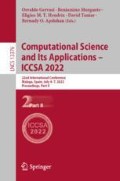Abstract
This contribution describes a new approach to formulation of ODE and PDE critical points using implicit formulation as t-variant scalar function using the Taylor expansion. A general condition for the critical points is derived and specified for t invariant case. It is expected, that the given new formulae lead to more reliable detection of critical points especially for large 3D fluid flow data acquisition, which enable high 3D vector compression and their representation using radial basis functions (RBF).
In the case of vector field visualization, e.g. fluid flow, electromagnetic fields, etc., the critical points of ODE are critical for physical phenomena behavior.
Research supported by the University of West Bohemia - Institutional research support.
Access this chapter
Tax calculation will be finalised at checkout
Purchases are for personal use only
Notes
- 1.
It should be noted that in the case of the PDE the coordinates\(\mathbf {x}\) are as sumed to be time independent.
References
Agoston, M.: Computer Graphics and Geometric Modelling: Implementation & Algorithms. Computer Graphics and Geometric Modeling, Springer, London (2005). https://doi.org/10.1007/b138805
Biancolini, M.: Fast Radial Basis Functions for Engineering Applications. Springer ,Cham (2018). https://doi.org/10.1007/978-3-319-75011-8
Bronson, R., Costa, G.B.: Matrix Methods: Applied Linear Algebra. Academic Press, Boston (2009)
Drake, K., Fuselier, E., Wright, G.: A partition of unity method for divergence-free or curl-free radial basis function approximation. SIAM J. Sci. Comput. 43(3), A1950–A1974 (2021). https://doi.org/10.1137/20M1373505
Goldman, R.: Curvature formulas for implicit curves and surfaces. Comput. Aid. Geomet. Des. 22(7 SPEC. ISS.), 632–658 (2005). https://doi.org/10.1016/j.cagd.2005.06.005
Goldman, R., Sederberg, T., Anderson, D.: Vector elimination: a technique for the implicitization, inversion, and intersection of planar parametric rational polynomial curves. Comput. Aid. Geomet. Des. 1(4), 327–356 (1984). https://doi.org/10.1016/0167-8396(84)90020-7
Helman, J., Hesselink, L.: Representation and display of vector field topology in fluid flow data sets. Computer 22(8), 27–36 (1989). https://doi.org/10.1109/2.35197
Huang, Z.B., Fu, G.T., Cao, L.j., Yu, M., Yang, W.B.: A parallel high-precision critical point detection and location for large-scale 3D flow field on the GPU. J. Supercomput. 78(7), 9642–9667 (2022). https://doi.org/10.1007/s11227-021-04220-6
Kabel, A.: Maxwell-Lorentz equations in general Frenet-Serret coordinates. In: Proceedings of the 2003 Particle Accelerator Conference. vol. 4, pp. 2252–2254 (2003). https://doi.org/10.1109/PAC.2003.1289082
Kim, K.R., Kim, P.T., Koo, J.Y., Pierrynowski, M.R.: Frenet-Serret and the estimation of curvature and torsion. IEEE J. Select. Topics Signal Process. 7(4), 646–654 (2013). https://doi.org/10.1109/JSTSP.2012.2232280
Koch, S., Kasten, J., Wiebel, A., Scheuermann, G., Hlawitschka, M.: 2D Vector field approximation using linear neighborhoods. Visual Comput. 32(12), 1563–1578 (2015). https://doi.org/10.1007/s00371-015-1140-9
Lebl, J.: Notes on Diffy Qs: Differential Equations for Engineers. CreateSpace Independent Publishing Platform (2021)
Scheuermann, G., Kruger, H., Menzel, M., Rockwood, A.P.: Visualizing nonlinear vector field topology. IEEE Trans. Visual. Comput. Graph. 4(2), 109–116 (1998). https://doi.org/10.1109/2945.694953
Skala, V.: Efficient Taylor expansion computation of multidimensional vector functions on GPU. Ann. Math. Informat. 54, 83–95 (2021). https://doi.org/10.33039/ami.2021.03.004
Skala, V., Smolik, M.: A new approach to vector field interpolation, classification and robust critical points detection using radial basis functions. Adv. Intell. Syst. Comput. 765, 109–115 (2019). https://doi.org/10.1007/978-3-319-91192-2_12
Smolik, M., Skala, V.: Classification of critical points using a second order derivative. Procedia Comput. Sci. 108, 2373–2377 (2017). https://doi.org/10.1016/j.procs.2017.05.271
Smolik, M., Skala, V.: Spherical RBF vector field interpolation: experimental study. In: SAMI 2017 - IEEE 15th International Symposium on Applied Machine Intelligence and Informatics, Proceedings, pp. 431–434 (2017). https://doi.org/10.1109/SAMI.2017.7880347
Smolik, M., Skala, V.: Reconstruction of corrupted vector fields using radial basis functions. In: INFORMATICS 2019 - IEEE 15th International Scientific Conference on Informatics, Proceedings, pp. 377–382 (2019). https://doi.org/10.1109/Informatics47936.2019.9119297
Smolik, M., Skala, V.: Radial basis function and multi-level 2d vector field approximation. Math. Comput. Simul. 181, 522–538 (2021). https://doi.org/10.1016/j.matcom.2020.10.009
Smolik, M., Skala, V., Majdisova, Z.: 3D vector field approximation and critical points reduction using radial basis functions. Int. J. Mech. 13, 100–103 (2019)
WiKi: Frenet-Serret-formulas (2022). https://en.wikipedia.org/wiki/Frenet%E2%80%93Serret_formulas. Accessed 18 Jan 2022
Acknowledgments
The author thanks to students and colleagues at the University of West Bohemia, Plzen and VSB-Technical University, Ostrava for their critical comments, discussions and especially to Michal Smolik for producing some images. Thanks belong also to the anonymous reviewers, as their comments and hints helped to improve this paper significantly.
Author information
Authors and Affiliations
Corresponding author
Editor information
Editors and Affiliations
Rights and permissions
Copyright information
© 2022 The Author(s), under exclusive license to Springer Nature Switzerland AG
About this paper
Cite this paper
Skala, V. (2022). Critical Points Properties of Ordinary Differential Equations as a Projection of Implicit Functions Using Spatio-temporal Taylor Expansion. In: Gervasi, O., Murgante, B., Hendrix, E.M.T., Taniar, D., Apduhan, B.O. (eds) Computational Science and Its Applications – ICCSA 2022. ICCSA 2022. Lecture Notes in Computer Science, vol 13376. Springer, Cham. https://doi.org/10.1007/978-3-031-10450-3_15
Download citation
DOI: https://doi.org/10.1007/978-3-031-10450-3_15
Published:
Publisher Name: Springer, Cham
Print ISBN: 978-3-031-10449-7
Online ISBN: 978-3-031-10450-3
eBook Packages: Computer ScienceComputer Science (R0)

